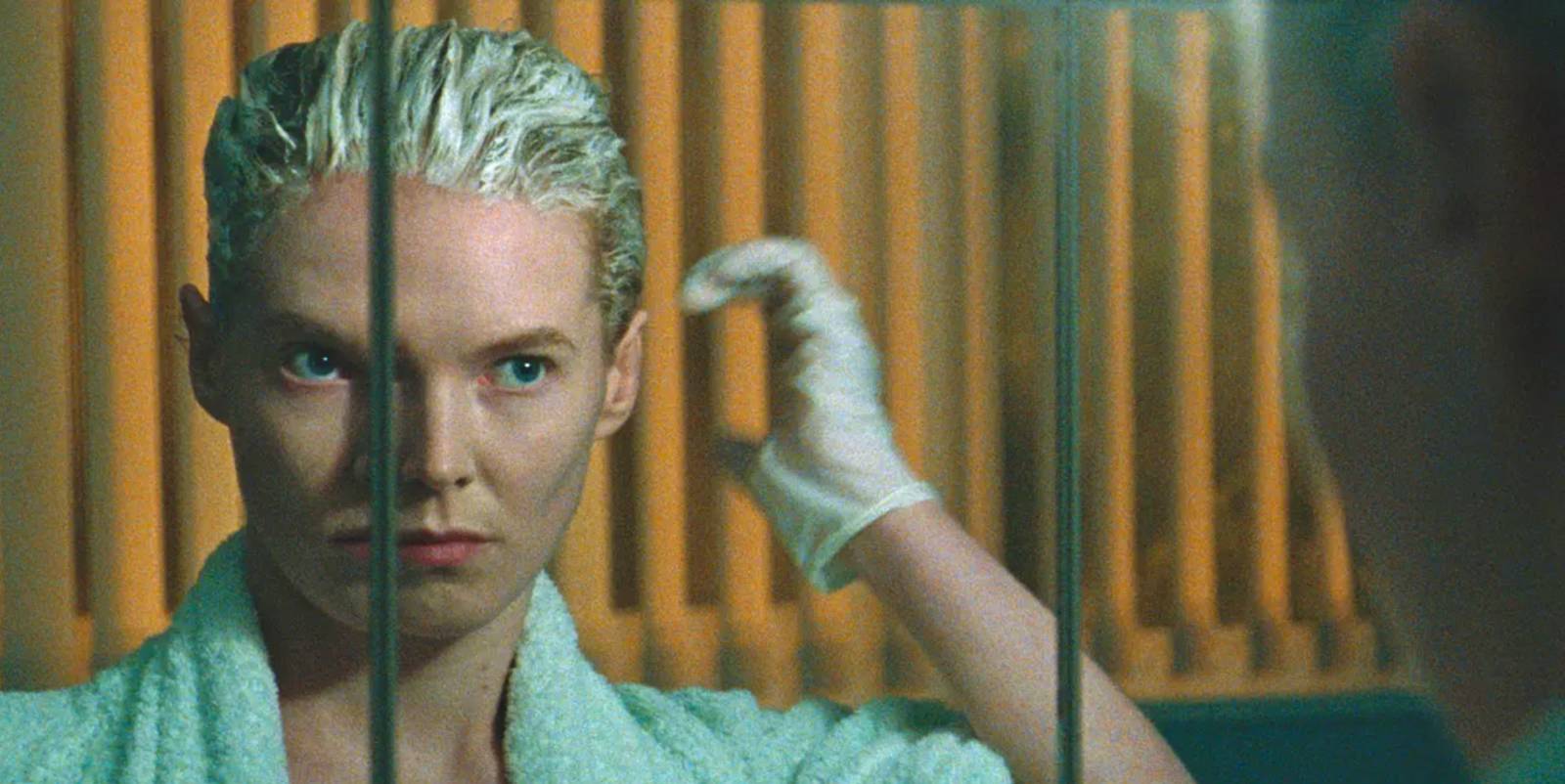The Blue Jean of David Bowie’s 1984 hit was a girl with “a camouflage face,” not unlike the singer and the two personas he splintered into for the song’s video: a djinn-like rockstar dancing onstage and his ordinary, besuited doppelganger watching from below. So it is for the young woman at the center of Georgia Oakley’s own Blue Jean. A PE teacher stranded in Tyneside, England, Jean (Rosy McEwen) is a divorcée in a same-sex relationship that no-one—least of all her pupils and co-workers—must ever know about. For the year is 1988 and Britain’s grappling with the revolting aftermath of Section 28. The bill passed by Thatcher’s government banned “the promotion of homosexuality” by local authorities, forcing people like Jean into hiding. Camouflaging—its costs and consequences—is at the cornerstone of Oakley’s frank, often quite gripping feature debut. If Blue Jean does not debunk or reinvent new tropes in its tale of self-acceptance (does it have to, anyway?) it still radiates a rebellious energy, courtesy McEwen’s riveting performance and Oakley’s ability to never make her outcasts feel like lessons.
Jean’s is, at its core, the story of a balancing act. With the Tories’ Orwellian slogans stalking her commute from giant billboards (“Are Your Children Being Taught Traditional Moral Values?”) and the casual homophobia permeating her workplace, code-switching becomes a lesson in survival. No one knows about Jean’s secret identity, and those who do—as her sister—peg it as a shameful and unspeakable fad (“You know I accept it,” the sibling says of Jean’s homosexuality, the “it” a beguilingly tiny word to encompass the immeasurable gap between the two women). It is only late at night, in the town’s few gay bars, that Jean can finally let go, shedding her daytime mask as she unwinds with her girlfriend Viv (Kerrie Hayes) and mutual friends. But camouflaging is an exhausting, increasingly difficult feat, which Oakley further complicates once a new teen joins Jean’s class. Clumsy, shy, unathletic Lois (Lucy Halliday) turns into a punching bag, her queerness immediately picked up by Jean as well as star student Siobhan (Lydia Page), who rallies her classmates into a no-holds-barred bullying crusade.
Little can Jean do to help Lois, lest she might expose herself and lose her job in the process. And that’s where the conflict of Blue Jean hinges: in an effort to fend off scrutiny of her own private life, Jean winds up implementing Section 28 herself, turning from victim into persecutor. It is credit to Oakley’s script that Blue Jean is as concerned about its heroine’s standing before her heterosexual acquaintances as it is about her relationship with gay friends and loved ones. The bill did not just enforce self-erasure, it also deprived countless people of their right to a community, making alliances impossible and impossibly dangerous—a predicament Jean sums up beautifully in a late chat with a traumatized Lois: “I can’t be that person for you.” Blue Jean, in a sense, doubles as a corrective. It’s not just Oakley’s forensic work that stuns one, impressive as that is. Soraya Gilanni’s production design shows a fastidious eye for period details, from tape recorders to Blind Date episodes beaming from Jean’s TV set, and the film conjures the pestilential climate of those years with the unflinching eye of a coroner. But evoking that mood isn’t Blue Jean’s only concern. Nor its most important.
What lingers more than any humiliations Jean and Lois both suffer is the space this film carves for solidarity between its many misfits. It culminates with a vision of an alternative, underground universe in which people like Jean—and Viv, and Lois—find solace in each other: not a utopia but a real-life place, a collective with its own rules and codes, its proto-bank, a safety net for members of all ages and backgrounds. Chromatically, Victor Seguin’s cinematography mirrors Jean’s catharsis shedding the blue-heavy palette of the early scenes for the warm reds of gay bars and shared houses.
Not all of it works. There are times when Blue Jean dips into a heavy-handed symbolism that makes for a strident contrast with its more delicate, organic sequences. Early in the film, Oakley returns to a shot of Jean’s cat and goldfish to underscore the woman’s claustrophobia and her impending doom; the choice rings more on-the-nose than illuminating. Later, Jean musters enough courage to unveil her true identity in public, and then walks down an empty road—half-laughing, half-crying—watching as horses run on the fields ahead. They’re minor blips, surely, and that they feel so out of place is also a backhanded testament to McEwen’s understated performance, a turn that siphons the sudsy out of the most sentimental moments. She’s Blue Jean’s protagonist and the source of its unbreakable spirit; even at her lowest, McEwen graces Jean with the kind of dignity that helps the film steer clear from miserabilism.
There’s a palpable synergy between actress and director, ensuring that the most intimate and devastating scenes do not register as voyeuristic but safe spaces for Jean to hurt and heal. It’s the same affection that radiates from the few moments of intimacy between the teacher and her girlfriend Viv—sex scenes that refuse to pander to the male gaze but frame bodies as strange, uncharted, extraordinary worlds. Section 28 would only be repealed a staggering fifteen years later, in 2003, and Oakley refuses to wrap things with a saccharine happily-ever-after. These interludes are the closest Jean ever is to reaching one, brief windows of time where her true self can come to light: defiant, luminous, unapologetically free.
Blue Jean screened at the Thessaloniki International Film Festival.

